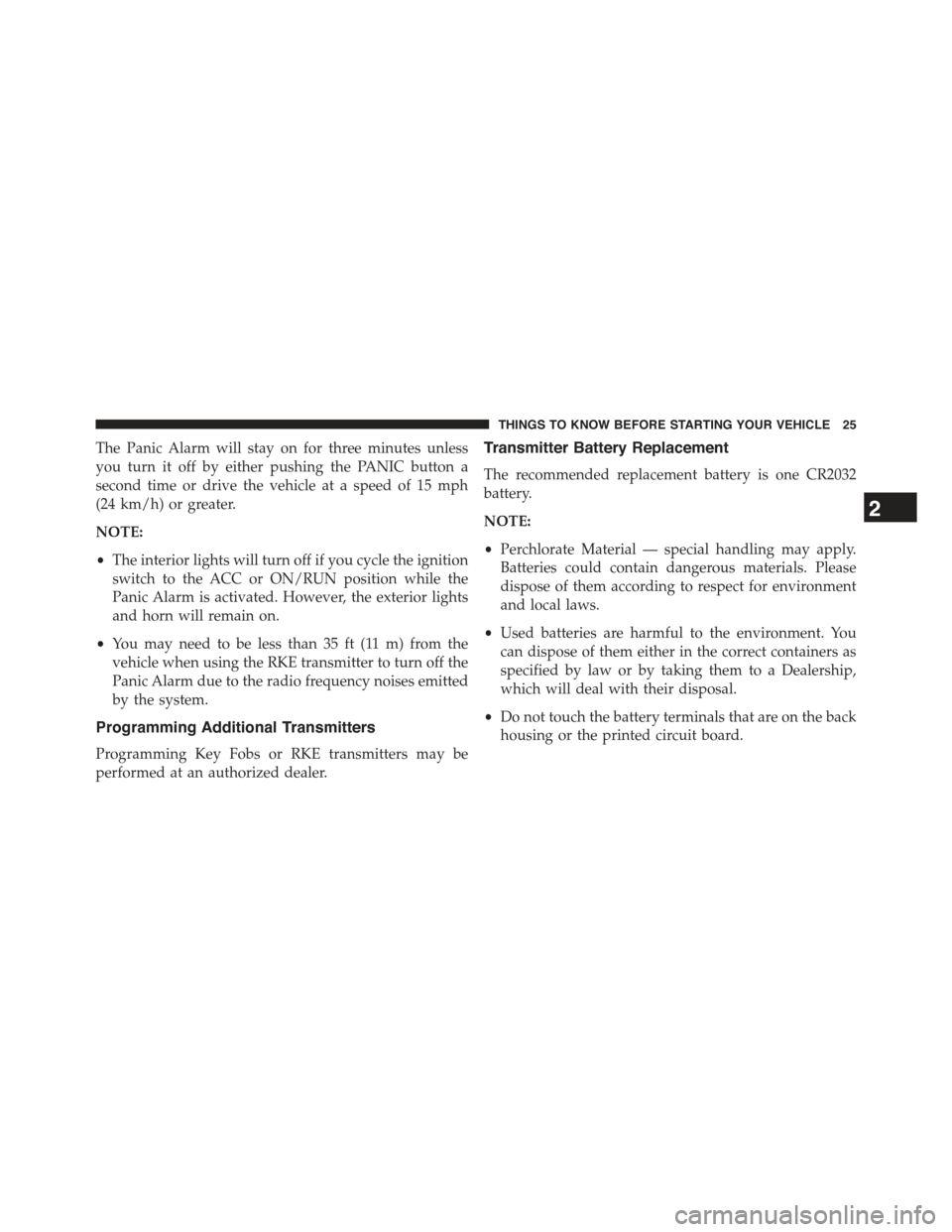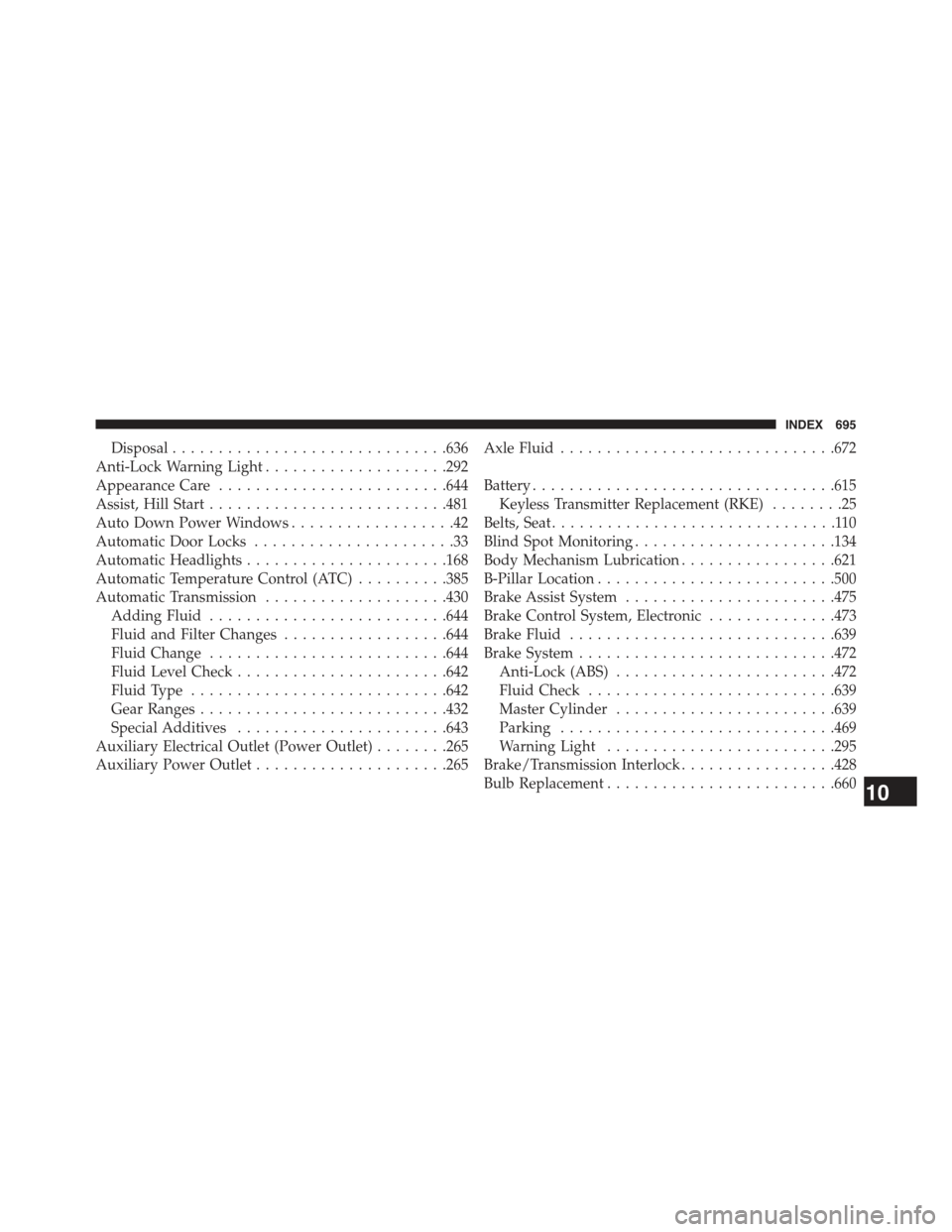Page 13 of 717
THINGS TO KNOW BEFORE STARTING YOUR VEHICLE
CONTENTS
!A WORD ABOUT YOUR KEYS.............13
▫Keyless Ignition Node (KIN)..............13
▫Key Fob . . . . . . . . . . . . . . . . . . . . . . . . . . . . .14
▫Ignition Or Accessory On Message..........15
!SENTRY KEY®.........................16
▫Replacement Keys.....................17
▫Customer Key Programming..............18
▫General Information....................18
!VEHICLE SECURITY ALARM — IF EQUIPPED . . .19
▫Rearming The System...................19
▫To Arm The System....................19
▫To Disarm The System...................20
▫Tamper Alert.........................21
!ILLUMINATED ENTRY — IF EQUIPPED......21
!REMOTE KEYLESS ENTRY (RKE)...........22
▫To Unlock The Doors And Liftgate..........23
▫To Lock The Doors And Liftgate............24
▫Using The Panic Alarm..................24
▫Programming Additional Transmitters.......25
▫Transmitter Battery Replacement...........25
2
Page 27 of 717

The Panic Alarm will stay on for three minutes unless
you turn it off by either pushing the PANIC button a
second time or drive the vehicle at a speed of 15 mph
(24 km/h) or greater.
NOTE:
•The interior lights will turn off if you cycle the ignition
switch to the ACC or ON/RUN position while the
Panic Alarm is activated. However, the exterior lights
and horn will remain on.
•You may need to be less than 35 ft (11 m) from the
vehicle when using the RKE transmitter to turn off the
Panic Alarm due to the radio frequency noises emitted
by the system.
Programming Additional Transmitters
Programming Key Fobs or RKE transmitters may be
performed at an authorized dealer.
Transmitter Battery Replacement
The recommended replacement battery is one CR2032
battery.
NOTE:
•Perchlorate Material — special handling may apply.
Batteries could contain dangerous materials. Please
dispose of them according to respect for environment
and local laws.
•Used batteries are harmful to the environment. You
can dispose of them either in the correct containers as
specified by law or by taking them to a Dealership,
which will deal with their disposal.
•Do not touch the battery terminals that are on the back
housing or the printed circuit board.
2
THINGS TO KNOW BEFORE STARTING YOUR VEHICLE 25
Page 601 of 717
MAINTAINING YOUR VEHICLE
CONTENTS
!ENGINE COMPARTMENT — 3.6L..........601
!ENGINE COMPARTMENT — 5.7L..........602
!ONBOARD DIAGNOSTIC SYSTEM (OBD II) . . .603
!EMISSIONS INSPECTION AND MAINTENANCE
PROGRAMS..........................603
!REPLACEMENT PARTS..................605
!DEALER SERVICE......................605
!MAINTENANCE PROCEDURES...........606
▫Engine Oil..........................607
▫Engine Oil Filter......................610
▫Engine Air Cleaner Filter................610
▫Accessory Drive Belt Inspection...........613
▫Maintenance-Free Battery...............615
▫Air Conditioner Maintenance.............616
▫Body Lubrication.....................621
▫Windshield Wiper Blades...............622
▫Adding Washer Fluid..................629
▫Exhaust System......................630
▫Cooling System......................632
▫Brake System........................638
7
Page 606 of 717

Indicator Light (MIL)” is functioning and is not on when
the engine is running, and that the OBD II system is
ready for testing.
Normally, the OBD II system will be ready. The OBD II
system maynotbe ready if your vehicle was recently
serviced, recently had a dead battery or a battery replace-
ment. If the OBD II system should be determined not
ready for the I/M test, your vehicle may fail the test.
Your vehicle has a simple ignition actuated test, which
you can use prior to going to the test station. To check if
your vehicle’s OBD II system is ready, you must do the
following:
1. Cycle the ignition switch to the ON position, but do
not crank or start the engine.
NOTE:If you crank or start the engine, you will have to
start this test over.
2. As soon as you cycle the ignition switch to the ON
position, you will see the MIL symbol come on as part
of a normal bulb check.
3. Approximately 15 seconds later, one of two things will
happen:
•The MIL will flash for about 10 seconds and then
return to being fully illuminated until you turn OFF
the ignition or start the engine. This means that your
vehicle’s OBD II system isnot readyand you should
notproceed to the I/M station.
•The MIL will not flash at all and will remain fully
illuminated until you turn OFF the ignition or start the
engine. This means that your vehicle’s OBD II system
isreadyand you can proceed to the I/M station.
If your OBD II system isnot ready,you should see your
authorized dealer or repair facility. If your vehicle was
recently serviced or had a battery failure or replacement,
604 MAINTAINING YOUR VEHICLE
Page 617 of 717

Belt replacement on some models requires the use of
special tools, we recommend having your vehicle ser-
viced at an authorized dealer.
Maintenance-Free Battery
Your vehicle is equipped with a maintenance-free battery.
You will never have to add water, nor is periodic main-
tenance required.
WARNING!
•Battery fluid is a corrosive acid solution and can
burn or even blind you. Do not allow battery fluid
to contact your eyes, skin, or clothing. Do not lean
(Continued)
WARNING!(Continued)
over a battery when attaching clamps. If acid
splashes in eyes or on skin, flush the area imme-
diately with large amounts of water. Refer to
“Jump-Starting Procedures” in “What To Do In
Emergencies” for further information.
•Battery gas is flammable and explosive. Keep
flame or sparks away from the battery. Do not use
a booster battery or any other booster source with
an output greater than 12 Volts. Do not allow cable
clamps to touch each other.
•Battery posts, terminals, and related accessories
contain lead and lead compounds. Wash hands
after handling.7
MAINTAINING YOUR VEHICLE 615
Page 697 of 717

Disposal..............................636
Anti-Lock Warning Light....................292
Appearance Care.........................644
Assist, Hill Start..........................481
Auto Down Power Windows..................42
Automatic Door Locks......................33
Automatic Headlights......................168
Automatic Temperature Control (ATC)..........385
Automatic Transmission....................430
Adding Fluid..........................644
Fluid and Filter Changes..................644
Fluid Change..........................644
Fluid Level Check.......................642
Fluid Type............................642
Gear Ranges...........................432
Special Additives.......................643
Auxiliary Electrical Outlet (Power Outlet)........265
Auxiliary Power Outlet.....................265
Axle Fluid..............................672
Battery.................................615
Keyless Transmitter Replacement (RKE)........25
Belts, Seat...............................110
Blind Spot Monitoring......................134
Body Mechanism Lubrication.................621
B-Pillar Location..........................500
Brake Assist System.......................475
Brake Control System, Electronic..............473
Brake Fluid.............................639
Brake System............................472
Anti-Lock (ABS)........................472
Fluid Check...........................639
Master Cylinder........................639
Parking..............................469
Warning Light.........................295
Brake/Transmission Interlock.................428
Bulb Replacement.........................66010
INDEX 695